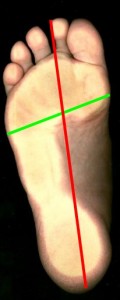BIOMECHANIC TIPS FOR BUYING A CYCLING SHOE
The problems involved in picking a fitting cycling shoe come up time and again in our bikefittings. In these conversations we notice that many cyclists are unsure as to which shoe model best suits their needs. For this reason we chose to write this guide providing you with some tips concerning shoe selection. A small qualification: Our tips refer to biomechanic aspects only – we won’t comment on design, colour or style ?
5 Tips for buying a cycling shoe
1. Length and width are decisive!
The own feet should be the decisive criterion when selecting a new shoe – it’s not only women trying to squeeze their feet into unfitting shoes just because they are sooo nice. Accordingly, two distances are important: the total foot length and the forefoot’s width. Experience shows that most people take foot length but few take foot width into account. That’s why we often see too narrow shoes during our bikefittings. If the forefoot for example is 10cm wide but the shoe only offers 9cm it is not surprising that the foot feels crushed and that problems emerge.
Our recommendation: Measure your feet prior to the shopping tour!
Step on a measuring tape and first measure the length (red line). Please keep in mind that the big toe is not necessarily the longest one! Then diagonally measure the width of the forefoot (green line). Take these two values as well as the measuring tape with you when looking for shoes. When you are interested in a shoe, take out the standard insole and measure both distances on that insole. Your values present the absolute minimum space the shoe needs to offer – up to 5mm more are acceptable (see tip 2!). In contrast to a running shoe, a fitting cycling shoe does not need more extra space (due to the fixed position on the pedals).
2. Consider the time of the day
Over the course of the day everyday strain causes the human foot to extend – both in length and in width. Different factors affect this extension (type and duration of the strain, temperature, etc.). That’s why we neither recommend buying a shoe in the morning nor following extreme stress (e.g. following a long run or a day standing at a trade fair). The afternoon would be the best compromise. If you buy the shoe for a special event (such as a stage race in the summer) you should try adapting the conditions when trying on the shoe (e.g. on a warm day). Generally, try staying as close to the usage conditions as possible when trying on a shoe.
3. Optimize the shoe through insoles
Insoles in cycling shoes are a clever way to connect the individually arched foot with the flat shoe sole. Insoles improve the pressure distribution and the force transmission as well as the shoe’s cushioning. BUT: Most of the current standard-insoles have no biomechanic function and don’t really deserve the name ‘insole’. Even though some companies make a first attempt to select the insole according to the rider’s foot type (which per se is positive), these pre-made insoles cannot keep up with individual insoles. An individual insole is constructed such that it is adapted to the special situation in the cycling shoe, the feet’s form and additional individual needs (such as the foot stance, or a slumped arch). Dynamic measurements on the own bike are optimal to detect the special needs and to take a look at both feet separately. As the foot stance in the cycling shoe is considerably different from the foot posture in a running shoe, beware that running insoles are no cycling insoles!
4. Heel guidance
Also how the shoe encloses the heel is an important criterion when buying a shoe. A heel cup that is too wide causes the foot to move more during the pulling phase. This diminishes the force transmission and causes a wobbly feeling.
But caution is also warranted if shoes have a too narrow heel cup. While in this case the foot is tightly enclosed and there is good guidance, the stiff material could cause the cup to compress the foot causing unpleasant pressure points. This can lead to a stained Achilles tendon.
Conclusion: When buying a shoe pay attention to a good, close fit of the heel, but never put up with possible pressure marks.
5. Foot types and closure systems
When considering the different models, also pay attention to the different closure systems. A high arched foot has a marked instep (‘back of the foot’) that would be unnecessarily compressed by a single closure. This could cause painful pressure marks when wearing the shoe. Especially for such cyclists we recommend a model with multiple closures to improve the pressure dispersion. Moreover, one should be able to adjust the closure (open/close) while riding.
Authors: Michael Fuhrmeister & Daniel Schade




